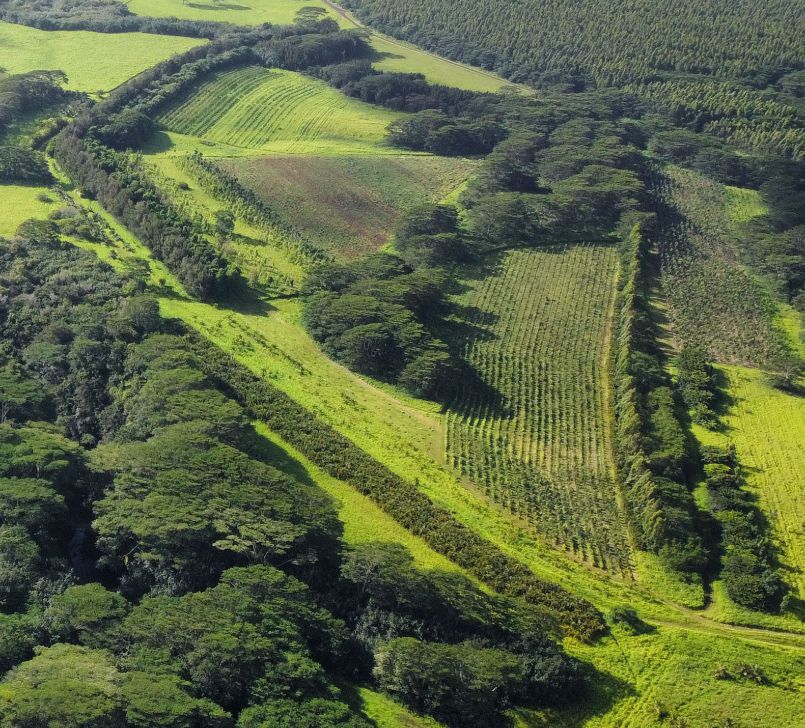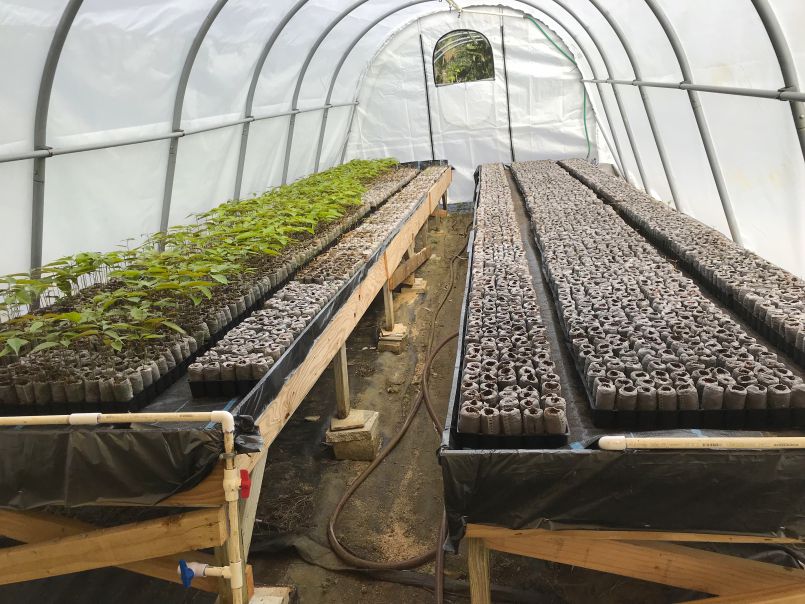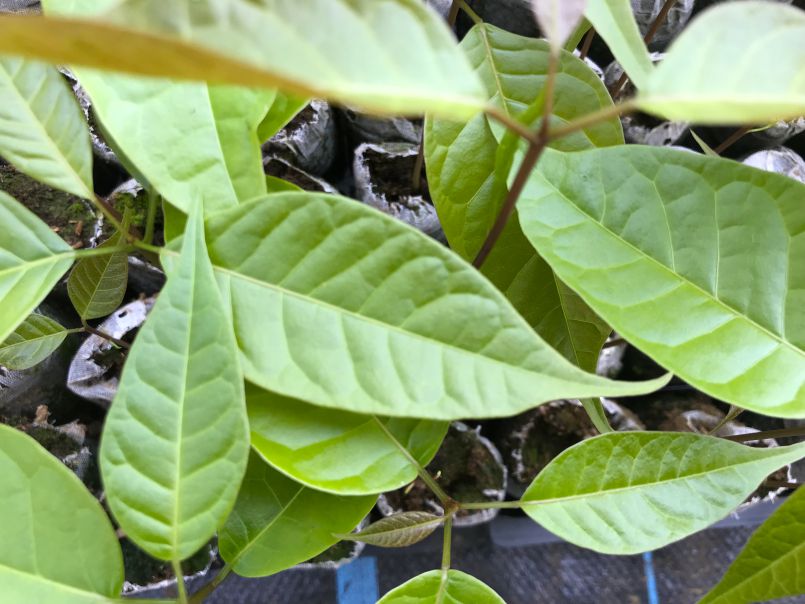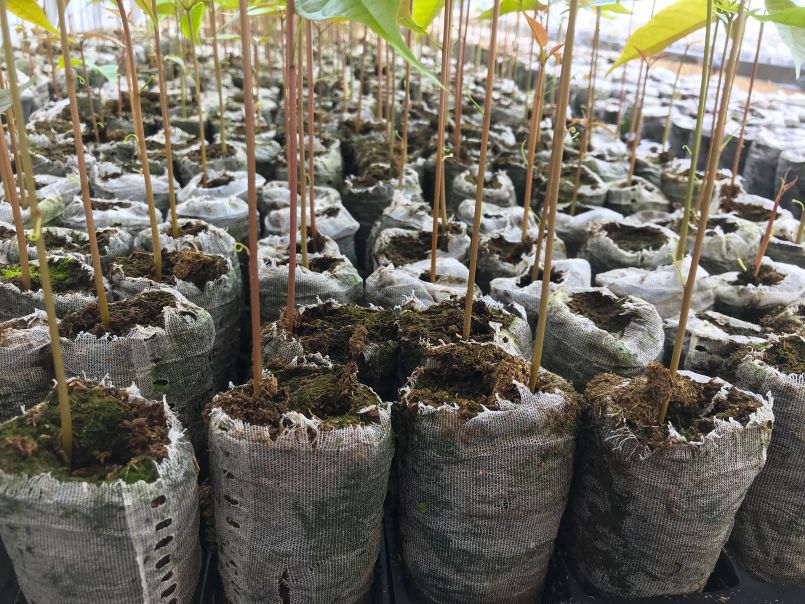Kauai Aadheenam's Hidden Hardwood Forests - A Retrospect of 20 years
October 8, 2021Not many visitors to Kauai's Hindu Monastery realize that a few dedicated monastics, along with a small hired crew have worked diligently over the past 20 years to plant and maintain a 100 acre forest of hardwood trees across the river, just a stones throw from the monastery. The trees now range from five foot saplings to fifteen year old trees up to 60 feet tall with plans to plant and/or replant a few more acres in the coming year.
Much of the land was originally covered with Koa and other native trees before it was cleared for sugar cane. Sugar cane became unprofitable and the land became available to the monastery in 2000. A small experimental planting took place following the 2002 celebration of Gurudeva's Mahasamadhi and in 2004 a long term lease was granted by the state of Hawaii and the large scale planting began.
Native Hawaiian Koa and large leafed mahogany are the two primary species grown with a few other varieties including teak and Narra planted here and there. Two aggressively invasive species of plant, guinea grass and albezia trees make maintenance of the trees mandatory and much more difficult that would otherwise be.
Eventually some of the trees will be judiciously harvested and either sold or used for monastery projects such as shrines and temples. Some of the most beautiful trees may be left for future generations and the harvested ones will be replanted with new trees.
Of special interest is an anticipated planting of especially tall, straight and mature teak trees which can be used for future kodimaram (traditional temple flagpole) installation and replacement for the monastery temple and other temples across the nation.

This aerial view of about 1\/3 of our forest land shows the orderly rows of threes and the L shaped row of more mature trees on the left.
Rows of trees.

A brave beginning. Once the lease for the land was secure, it was decided to plant 100 acres in hardwoods. Because the trade winds come in off of the ocean and are funneled up the Wailua River to our planting site by the foothills on either side, we decided to plant windbreaks first. These tiny ironwood trees were planted in 2004 to act as windbreaks and were the first large scale planting towards the final goal of 100 acres.
The windbreaks were planted in two rows with plastic to hold out weeds and hold in moisture. Land has been cleared on the left for the first large planting of hardwoods.
In just a few years they have grown much taller.
After 16 years the ironwood give strong protection for the plantings downwind.

Meanwhile, we have built a small nursery and have grown thousands of seedlings. These are \"big-leafed\" mahogany which is one of the two true mahogonies on the planet.

A close up shot of the vital young mahogany leaves.

The special peat pellets that we use to keep the roots from being damaged during planting. The roots will grow right through the biodegradable mesh on the sides and bottom.
Mahogany in the back of our truck and ready to go to the fields for planting.
The same trees, now 20 feet tall. In its first few years of life mahogany reaches up for the sunlight and the life it gives. Growing in thick jungles, it survives by growing straight up with a very small crown at the top and no initial branching out.
These mahogany, planted in 2007, are about 40 feet tall and doing very well.
Koa, considered sacred by the Hawaiians, is the other tree we have primarily planted. In recent years a root disease has destroyed much of the low altitude koa in the islands and so we purchased seed stock which was bred from disease resistant trees. Our plantings are the first commercial plantings of these specially bred trees, and others are now following with plantings of their own.
In 7 years the Koa have grown quite tall. In the foreground is the ever present guinea grass which can grow up to 12 feet tall and which forms a very thick root mat, stealing water and nutrients from the trees.
The beautiful trunk of a seven year old Koa.
A friend of the monastery had a planting of a beautiful hardwood called Narra, the national tree of the Philipines. We helped him prune his trees and then pushed the large pruned branches into the ground where they have taken root.
The Narra trees now, about 50 feet tall.
Our faithful case tractor was purchased from the sugar cane companies when we first obtained the lease and has served us well.
The two tractors we use for mowing.

A D-8 Caterpillar bulldozer dwarfs the pickup truck parked next to it. Much of the soil is compacted and has a layer of \"hard pan\" which makes it difficult for the trees, especially Koa, to get established. We hire this and other similar tractors to come in and break up the soil. The teeth on the blade are for seperating grass and branches from the dirt and the 4 ft rippers that are used to till the soil are mounted on the back.
The first creation to come from the trees of Kauai Aadheenam. When some of the experimental Koa planting of 2002 died from root disease we harvested the wood and this 12 inch Hawaiian style bowl was the result. The branches and debris from the harvest were placed back in the fields to return to the soil and the cycle was complete; a good beginning for the full 100 acres that we have now planted. Much work still remains in mowing, protecting from invasive species, thinning and eventually harvesting the trees, but we have reached a significant milestone.
}
];